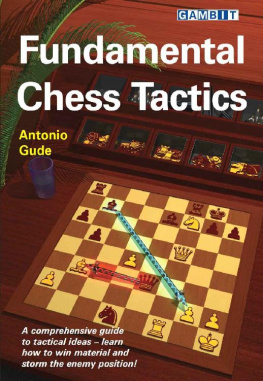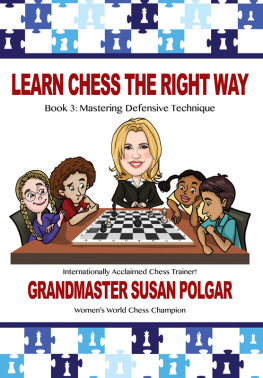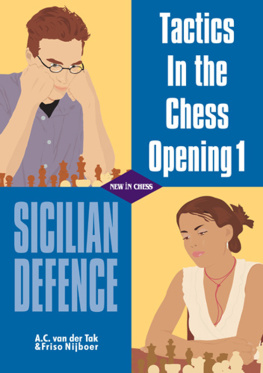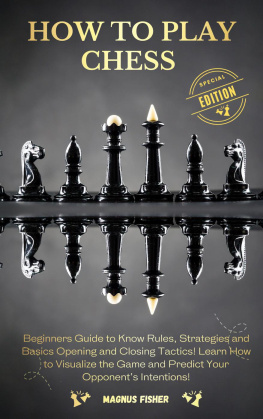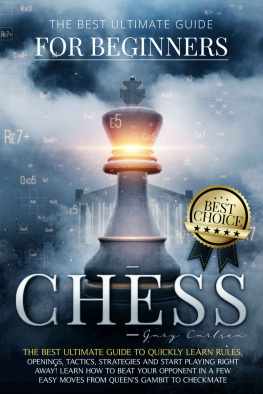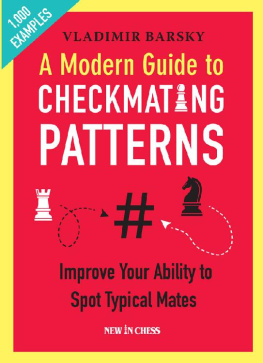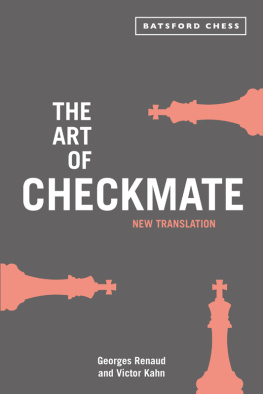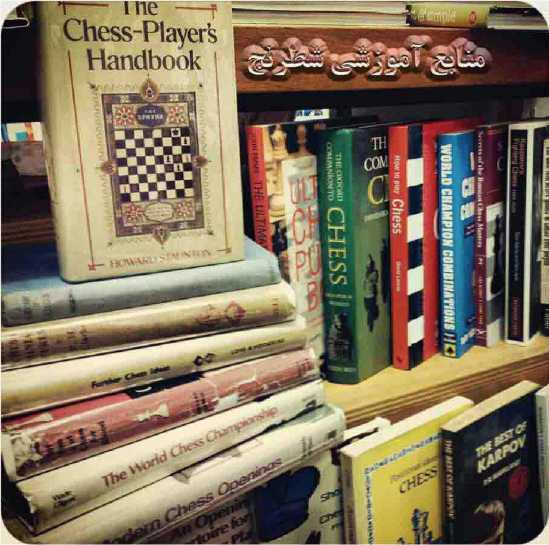undame
I/':*..
ntomo
Gude
\ complete study of mating patterns, mechanisms and combinations
Fundamental Checkmates
"CHESS EDUCATIONAL RESOURCES"
telegram channel address: https://telegram.me/ChessWorldChess
Antonio Gude
Translated by Phil Adams
A complete study of mating patterns, mechanisms and combinations
Contents
Symbols
Preface
Introduction
Part 1: First Steps
1: Strategy, Tactics, Combinations 2: The Basic Mates 3: Named Mates
4: Mating Positions Using a Single Piece 5: Combinative Patterns
Part 2: Mating Combinations Using Two Pieces
6: Queen + Rook
7: Queen + Bishop
8: Queen + Knight
9: Queen + Pawn
10: Rook + Rook
11: Rook + Bishop
12: Rook + Knight
13: Rook + Pawn
14: Bishop + Bishop
15: Bishop + Knight
16: Knight + Knight
17: King + Piece
18: Minor Piece + Pawn
Training Positions: First Set
Part 3: Target: The King in the Centre
19: King on its Back Rank 20: King on its Second Rank 21: King on its Third Rank Training Positions: Second Set
Part 4: Target: The Castled King
22: Rook Sacrifices 23: Bishop Sacrifices
24: Knight Sacrifices
25: Queen Sacrifices
26: Multiple Sacrifices
27: Exceptional Combinations
Training Positions: Third Set
Solutions to the Training Positions
Index of Names
Copyright Information About the Author About Gambit Publications Other Gambit Titles on Kindle
Symbols
x capture + check
++ double check # checkmate 0-0 castles kingside
0- 0-0 castles queenside !! brilliant move
! good move
!? interesting/probably good ?! dubious ? bad move ?? blunder Ch Championship
1- 0 the game ends in a win for White V2-V2 the game ends in a draw
0-1 the game ends in a win for Black ( n ) nth match game (D) see next diagram
Preface
Chess is imagination.
D AVID B RONSTEIN
I think that a chess game is an analytical problem which always has a solution.
ALEXANDER K HALIFMAN
The dynamism that characterizes modern chess has made it ever harder to define the role that strategy plays.
Strategy does, of course, exist and its presence is felt throughout the whole game. Nonetheless, the concept of a game of chess as an entity in which a strategic plan could be worked out and applied throughout the game has nowadays been overtaken by events. But this is nothing truly new. Because from the 1940s onwards the best Soviet chess masters had introduced a new dynamism into the game, according to which the various forms of compensation (better position or initiative in exchange for material, asymmetrical positions, etc.) constituted an effective attempt to transform the static era that prevailed in the first four decades of the 20th century.
Botvinnik was part of this movement and demonstrated his overall superiority by becoming world champion in 1948. But it was above all Geller and Bronstein, and then, in the generation of the 1960s, Spassky, Tal and Stein (with Fischer, of course, in North America) who were the most brilliant champions of the new dynamism. Subsequently, Kasparov, world number one for nearly twenty years in total, was the main representative of a way of playing which undermines, right from the opening, the opponents game, creating continuous pressure and complications. His most notable followers were, in the 1990s, Alexei Shirov to begin with, and a little later Alexander Morozevich.
It was Kasparov himself who made some revealing declarations on the Internet concerning the confrontation (in May 1990) between the Israeli team and the Junior chess program: The fact is that it does not matter how good the position is after the opening, it does not matter what positional mistakes the computer might have made in an unusual move-order: the fate of the game will, more often than not, be decided in tactical complications. It seems to be clear that the tactical factor plays a much more important role in the game than we previously thought.
Strategy refers to large plans, the global view of the game, the much-mentioned what to do , as opposed to how to do it . But it happens that the ultra-dynamic action of the modern game makes us try in the opening itself to twist in every way the foreseeable destiny of the game and both players tend to get tangled up in a close hand-to-hand struggle, which cannot be more precisely identified than as tactics , in the fullest sense of the word.
Nowadays, strategy can begin even before the game; the player prepares an opening and variations and tries to match them to his playing style. From the moment when he decides what kind of game he wants and plans to play, he is to some extent determining the way the game will proceed: to take the struggle to a purely positional plane, to a complicated playing field with possibilities for both sides, to yield the initiative, to take control of it at all costs... All of these attitudes are more strategic than psychological, because what the player decides a priori will to some extent become a part of the development of the game, ideas and plans being transferred in terms of the opening and the specific variation chosen.
What is the objective of this book? There is, if course, an objective and a very precise one: the technique of the mating combination; or, in a word, mate , which is, by definition, the ultimate objective of our game. Obviously it would be absurd to claim to reduce all chess combinations to models and typical themes, given that the combinative possibilities of chess games and moves are practically unlimited. More than seventy years ago the mathematician Kraitchik informed us that while the number of atoms that make up the observable universe is in the order of 10 70 , the number of possible games of chess is approximately 10 120 . And so, who are we, mere mortals, to claim to reduce chess to models?
The attempt to extract thematic combinations and reduce them to models is not, however, a senseless undertaking. Just as architects and painters study in great detail the basic materials that they will use in their works of art without this restricting their creative ability (it will, on the contrary, give it consistency), so it is no less legitimate for chess-players to study the raw materials with which they will work: the powers of the pieces, the ways in which they work together, and typical structures. Combinative themes, tactics and attacking play have been the subject of some valuable studies, amongst others those carried out by writers such as Bondarevsky, Vukovic, Voellmy, Tal (about the attack), and Euwe and Pachman, on the middlegame and tactics in general. There are also those who have written about specific combinations; Kurt Richter stands out, as well as Romanovsky, Kotov and Bronstein, and there is a special mention for Lisitsyns exceptional work, Strategy and Tactics (which, in spite of its title, is a book exclusively about tactics). It is also only fair to recognize the worth of the Argentine writer Roberto Grau, whose General Treatise on Chess has nurtured generations of Spanish and Latin American chess-players.
However, I do not think that anyone has attempted, until now, to make a rigorous classification of the basic mechanisms of checkmate, nor to reduce to models both the mating patterns and the typical mating combinations. That effort has been made here. Taking into account the difficulties involved in a work of investigation, I beg for a certain amount of good will, because the mysteries of chess are as difficult to grasp as they are to express. Every classification has its limitations, and even more so the topic which we have in hand, but the need to make the work systematic demands that effort to strip down and classify the mating combinations, so that we can finally begin to study them in all their ramifications.


